RARE! WWII 1943 Operation Husky "Type 1" Landing Craft D-Day Invasion Beachhead Military Intelligence Combat Action 8x10 Photograph







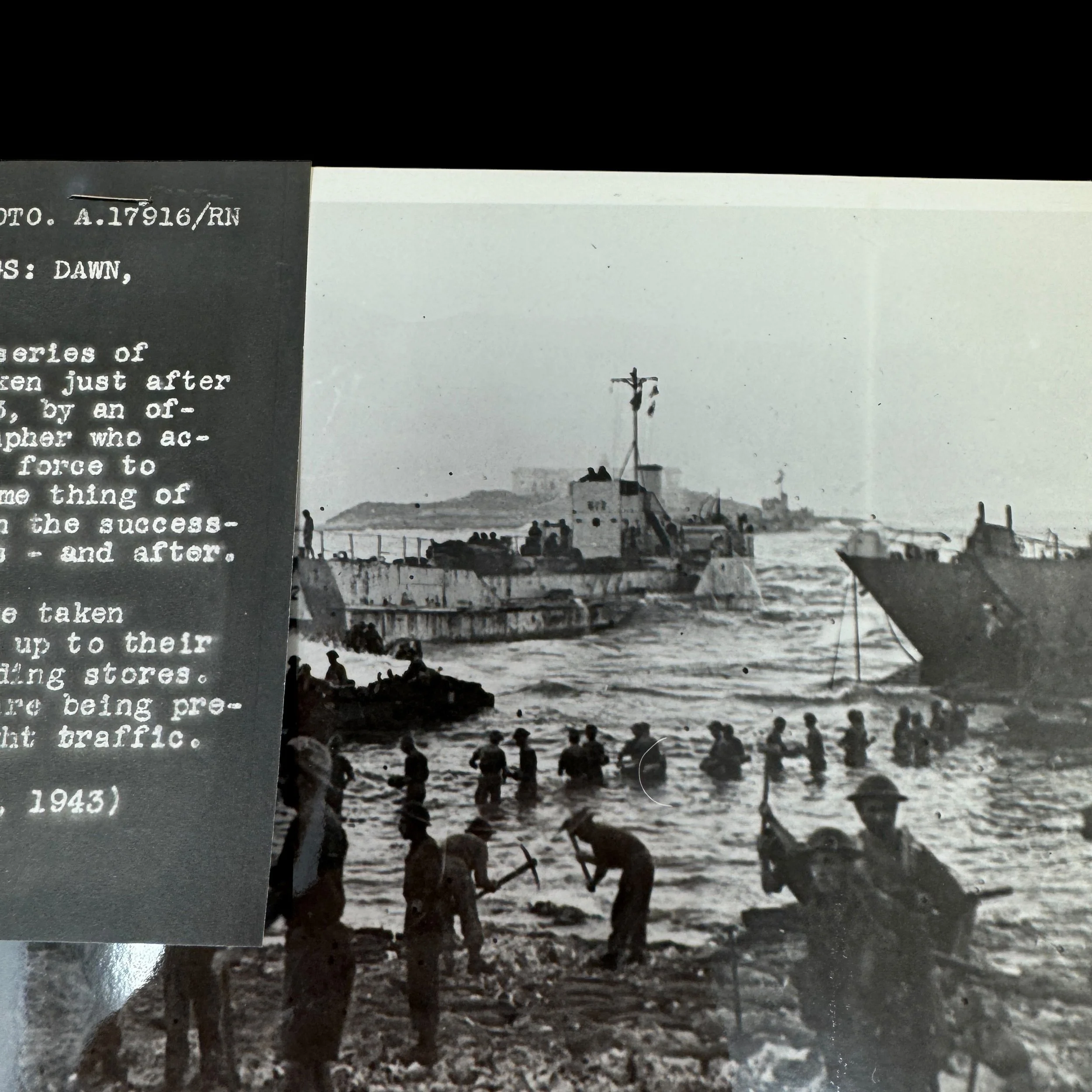
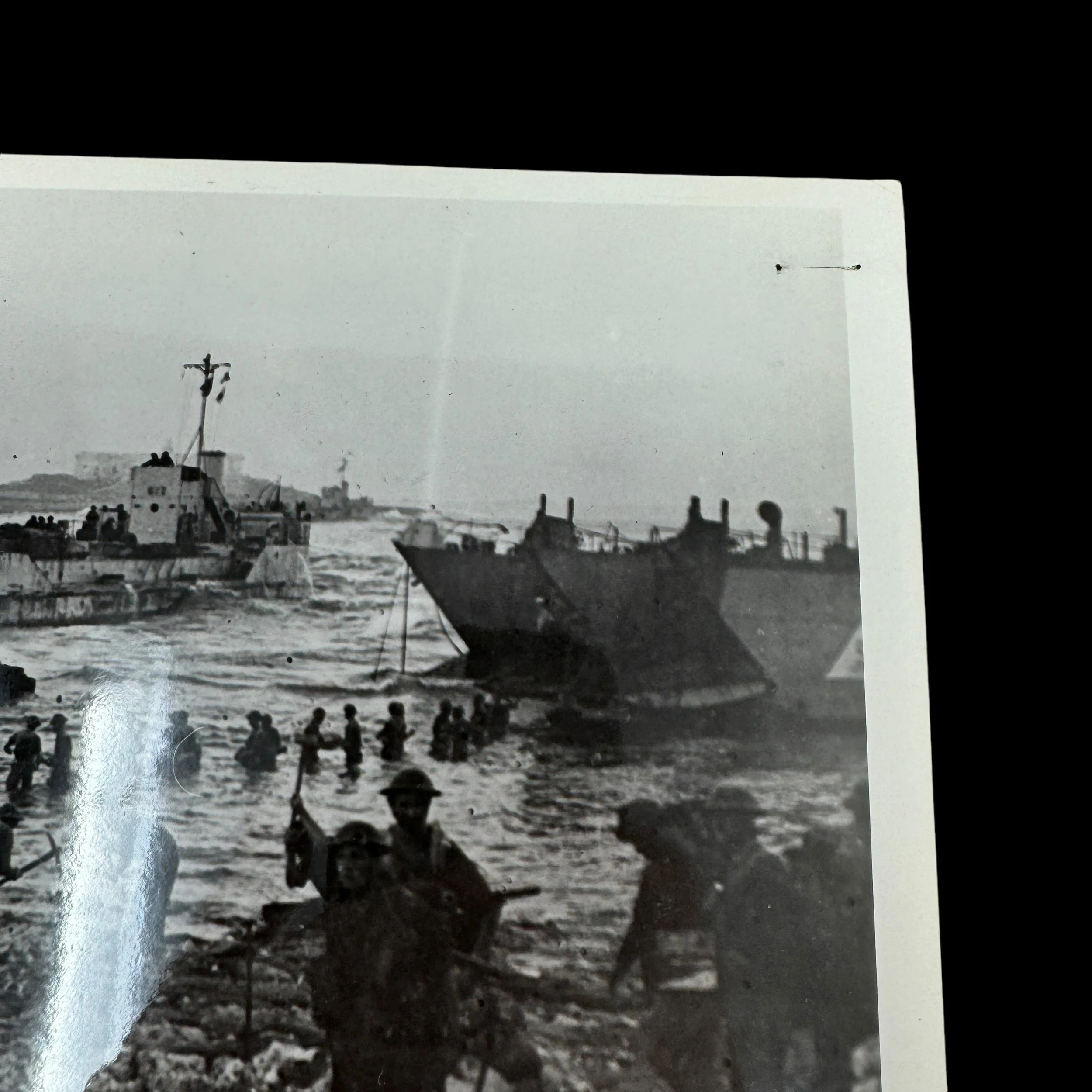
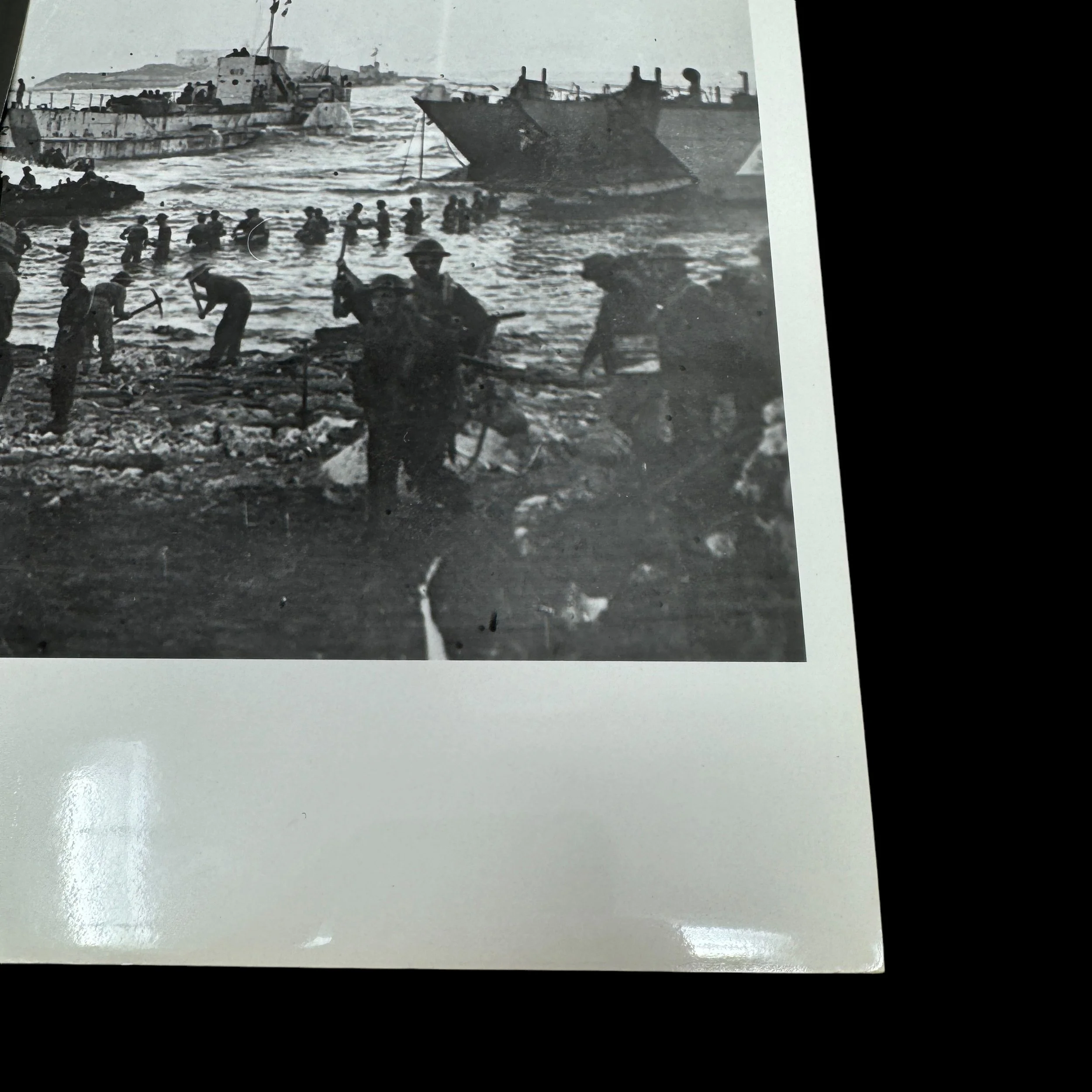
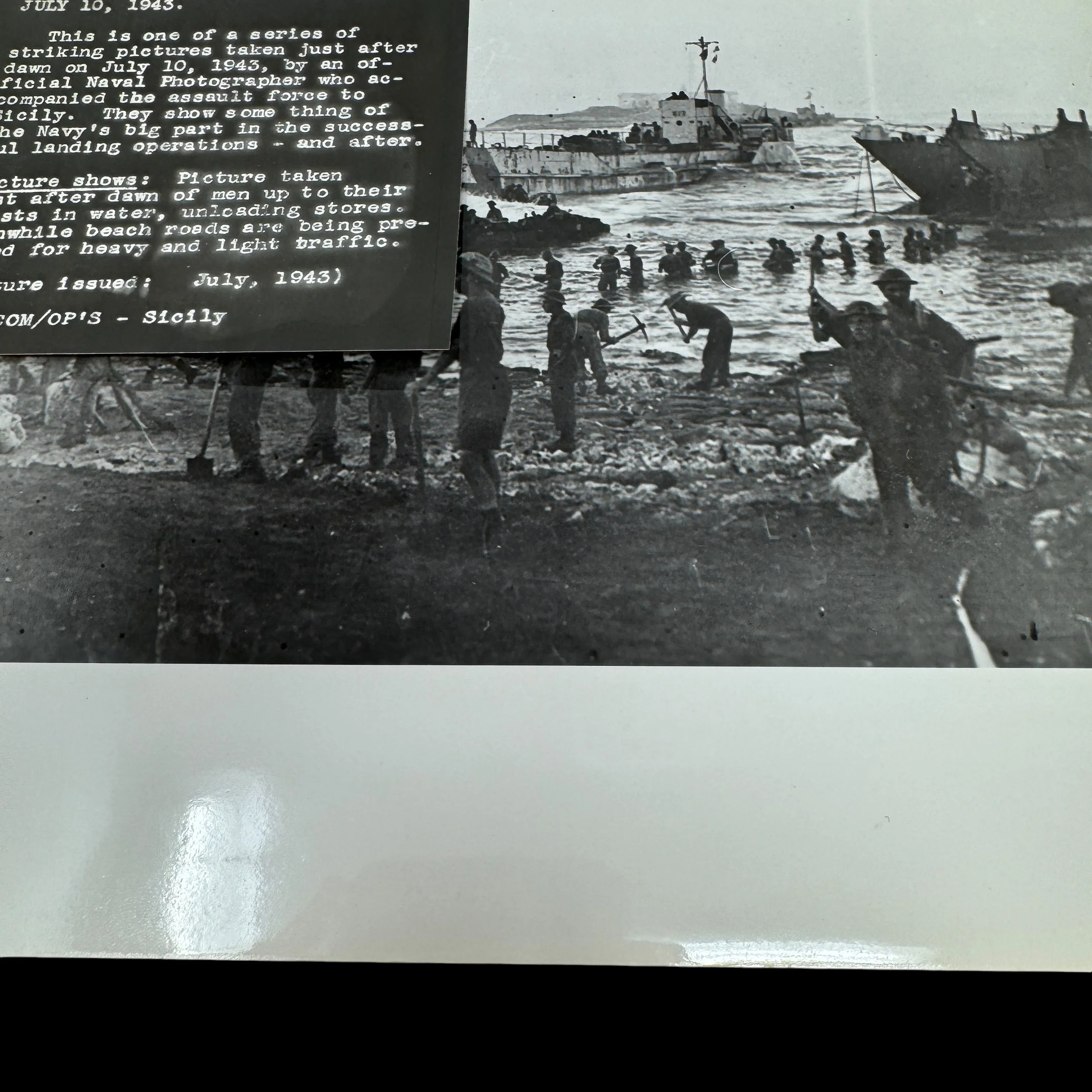

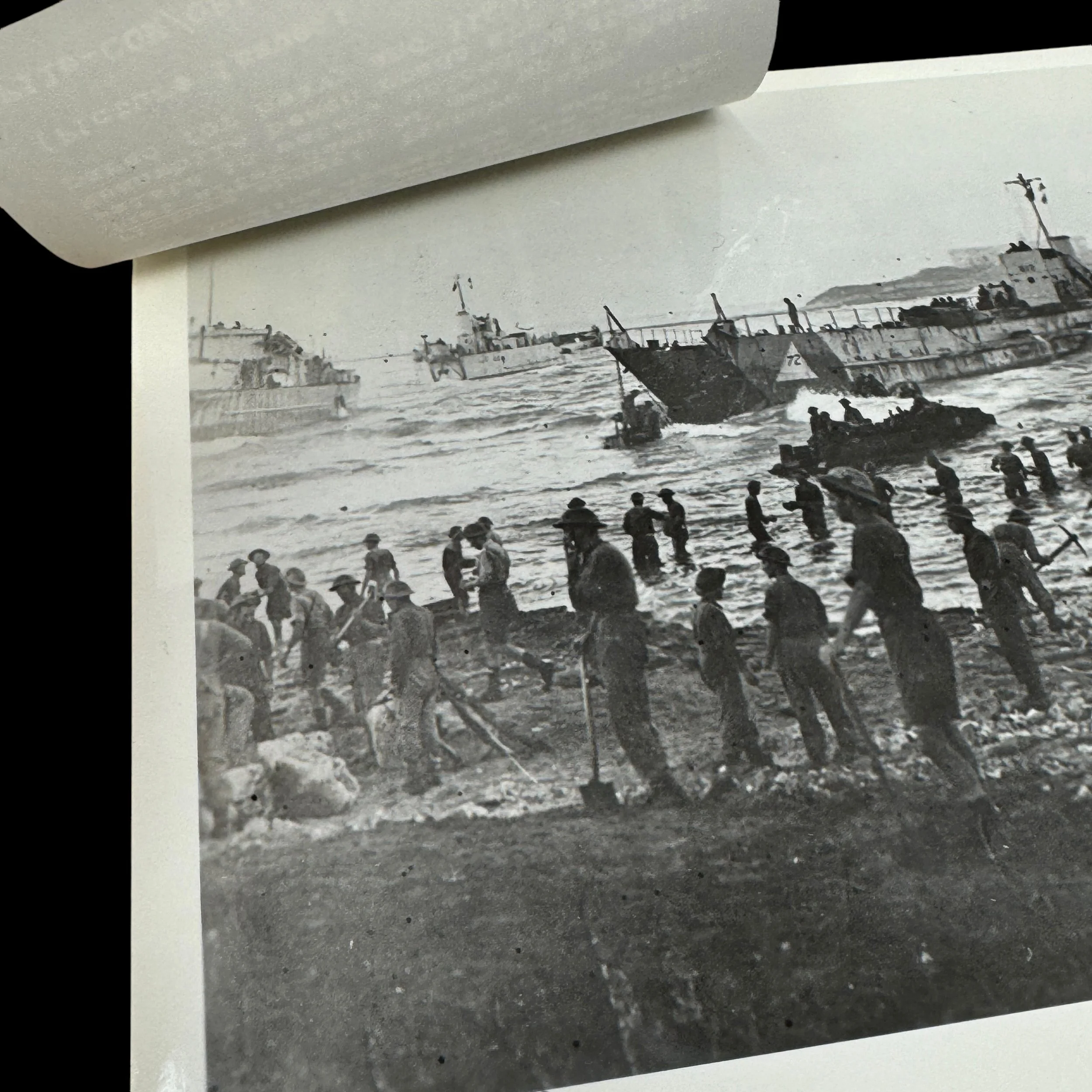

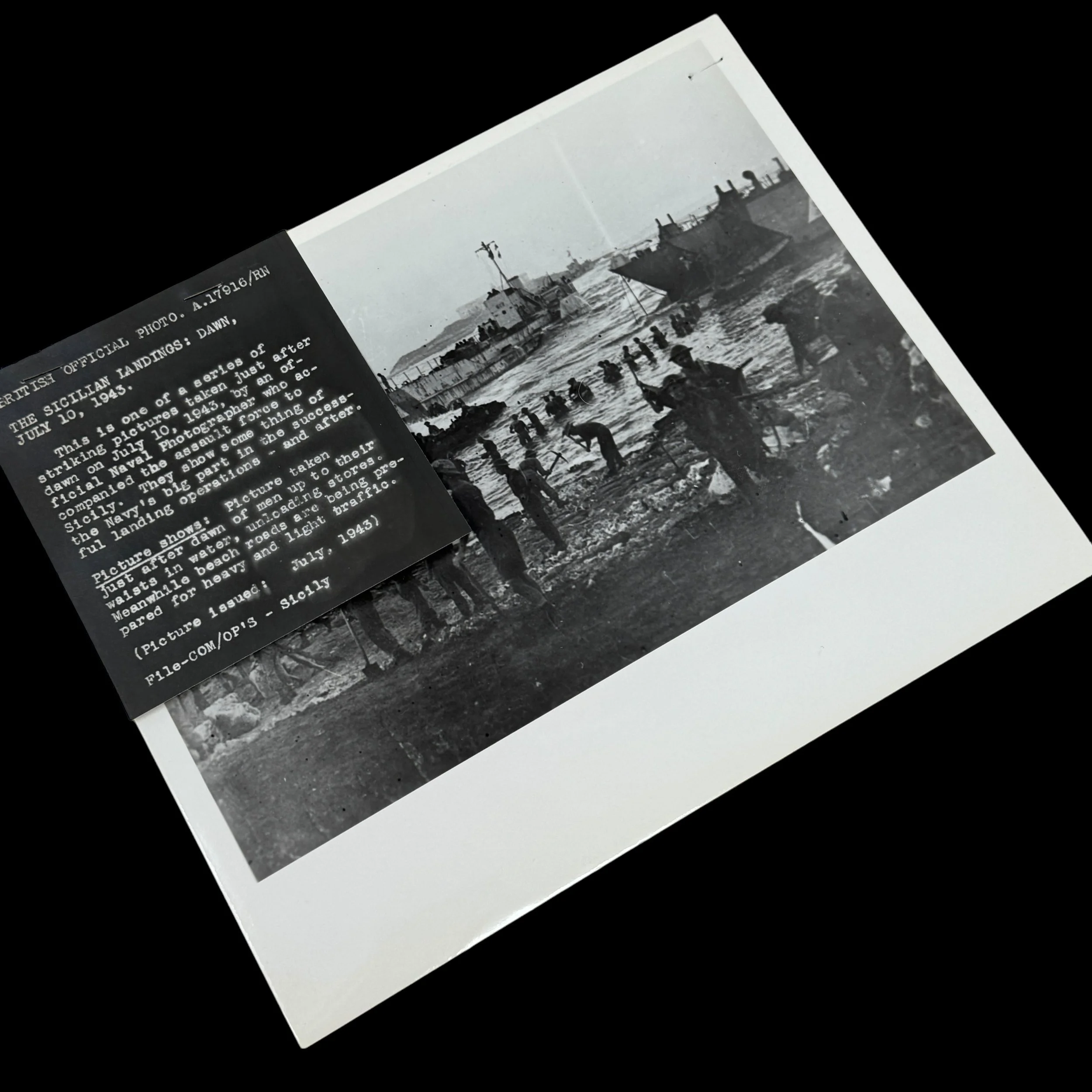
RARE! WWII 1943 Operation Husky "Type 1" Landing Craft D-Day Invasion Beachhead Military Intelligence Combat Action 8x10 Photograph
Comes with hand-signed C.O.A. and a full historical write-up
Size: 8.25 × 10 inches
This incredibly rare and museum-grade TYPE ONE original military intelligence photograph of the WWII Landing Crafts during the D-Day Sicily landings in 1943. This rare Type 1 photograph shows a detailed view of multiple Landing Crafts and British soldiers in the combat zone.
The Role of British Landing Crafts in the D-Day Invasion of Sicily (Operation Husky), 1943
World War II was defined by complex amphibious operations, where the coordination of naval and land forces played a decisive role in shaping the outcome of the war. Among these operations, the D-Day landings in Sicily—code-named Operation Husky, which began on July 9, 1943—stand as one of the most significant, marking the Allied push into Axis-controlled Europe. British landing crafts were at the heart of this operation, playing a pivotal role in transporting troops, equipment, and supplies to the beaches of Sicily. This essay will explore the types of British landing crafts used, their design and functionality, and how they contributed to the success of Operation Husky.
The Strategic Importance of Sicily
Before delving into the specifics of the landing crafts, it's essential to understand the strategic significance of Sicily during World War II. By 1943, the Axis powers—Nazi Germany and Fascist Italy—were deeply entrenched across Europe, controlling vast swathes of territory. The Allies sought to create a second front to relieve pressure on the Soviet Union and force Axis forces to defend multiple points. Sicily, located between Italy and North Africa, was a critical stepping stone into mainland Italy and eventually into the heart of Europe.
Operation Husky was the largest amphibious invasion to date, involving British, American, and Canadian forces. The objective was to capture the island from Axis forces, eliminate it as a staging ground for German and Italian naval and air operations, and pave the way for the invasion of Italy.
Types of British Landing Crafts Used in Operation Husky
The British Royal Navy deployed various types of landing crafts during Operation Husky, each designed for a specific purpose, from transporting infantry to landing tanks and heavy equipment. Among the most prominent were the Landing Craft Assault (LCA), Landing Craft Mechanized (LCM), Landing Craft Tank (LCT), and the Landing Ship Tank (LST). Each had its strengths and limitations that influenced the operation.
1. Landing Craft Assault (LCA)
The LCA was one of the most iconic and widely used British landing crafts in World War II. It was a small, armored vessel designed to transport assault troops directly onto beaches under heavy fire. The LCA was equipped with a shallow draft and a ramp at the front, allowing soldiers to quickly disembark once the craft reached the shore.
In Operation Husky, LCAs were instrumental in the initial stages of the invasion. British commandos and infantry units, including the 1st Airborne Division and the 8th Army under General Montgomery, were ferried to the beaches by LCAs. These landing crafts faced heavy Axis resistance, particularly from the well-prepared Italian coastal defenses. Despite this, the LCAs' speed and ability to land troops in shallow waters ensured that many soldiers were able to hit the beaches relatively quickly, overwhelming Axis positions.
The British LCAs distinguished themselves in night-time landings, which were a critical element of the Sicilian invasion. In an effort to surprise the Axis defenders, British forces launched night assaults, and the LCAs, with their relatively silent engines and low profiles, were ideal for these covert landings. However, they were vulnerable to enemy fire due to their light armor, and many LCAs were damaged or destroyed during the initial assault.
2. Landing Craft Mechanized (LCM)
The LCM was designed to carry heavier loads, including vehicles and equipment, onto beaches. Unlike the smaller LCA, the LCM could transport light tanks, jeeps, and artillery pieces, making it an essential part of the logistics chain during amphibious assaults. With the ability to carry a 30-ton payload, the LCM played a crucial role in transporting mechanized units necessary to maintain momentum once the initial beachhead was established.
During the D-Day invasion of Sicily, the British LCMs ferried tanks, Bren Gun Carriers, and artillery to support the infantry. These mechanized units were essential in quickly breaking through the Axis defensive lines. The rough terrain of Sicily, combined with the entrenched positions of German and Italian forces, required the mobility and firepower of tanks, which could only be delivered to the front lines by landing crafts like the LCM.
While the LCMs were indispensable, they also faced challenges during Operation Husky. High waves and enemy fire sometimes hampered their landing efforts, leading to delays in deploying crucial equipment. Additionally, the rocky coastlines of some landing zones posed difficulties for the LCMs, as their flat-bottomed design, while ideal for beach landings, made them vulnerable to becoming stuck on submerged rocks.
3. Landing Craft Tank (LCT)
The LCT was a larger vessel designed to transport tanks and heavy vehicles directly onto the beach. The LCT could carry multiple tanks and was critical in bringing in the heavier armored vehicles needed for the breakout from the beachheads. The LCT had a shallow draft, which allowed it to approach closer to the shore, and a front ramp that opened to allow tanks to roll directly onto the beach.
British forces relied on LCTs to land their heavy Churchill and Sherman tanks during the invasion of Sicily. These tanks were vital for the subsequent inland operations, where armored support was needed to overcome entrenched German and Italian positions. The British 8th Army, in particular, benefited from the swift arrival of tanks, which helped them push northward toward the heavily fortified town of Catania.
The use of LCTs in Operation Husky underscored the importance of maintaining momentum in an amphibious invasion. The ability to quickly land tanks and armored vehicles allowed the British to establish a secure foothold on Sicily, which was crucial for repelling Axis counterattacks.
4. Landing Ship Tank (LST)
The Landing Ship Tank (LST) was a larger version of the LCT, designed to carry even heavier loads, including multiple tanks, trucks, and large quantities of supplies. While not as nimble as the smaller landing crafts, the LST was vital for sustaining the invasion effort by providing a continuous flow of reinforcements, vehicles, and supplies.
During Operation Husky, British LSTs played a crucial role in delivering reinforcements to the beaches after the initial landings. As the battle for Sicily progressed and the Allies pushed further inland, LSTs ensured that the supply lines remained open, providing much-needed ammunition, fuel, and medical supplies to the front lines.
The LSTs also served as floating repair depots for damaged vehicles, allowing the British to maintain their armored strength throughout the campaign. Their ability to carry vast quantities of material made them indispensable for sustaining the momentum of the invasion.
British Landing Craft Tactics in Operation Husky
The successful execution of Operation Husky relied heavily on the coordination between the British Royal Navy and ground forces. The landing crafts were the backbone of this coordination, as they were responsible for delivering troops, vehicles, and supplies in a timely manner. Several key tactics contributed to their effective use during the invasion.
1. Night Landings and Surprise
British forces emphasized the element of surprise in their landings on Sicily. Many of the initial landings took place at night, with LCAs transporting commandos and infantry units in the dark. The night-time landings allowed the British to achieve a degree of tactical surprise, catching many Axis forces off guard. The quiet engines of the LCAs, combined with the darkness, allowed the British to land on the beaches with minimal detection.
2. Naval Gunfire Support
British landing crafts worked closely with naval gunfire support during the invasion. As the LCAs and LCMs approached the beaches, British warships bombarded enemy positions, softening defenses and reducing the risk to the landing troops. The close cooperation between the landing crafts and the Royal Navy's heavy guns was essential for ensuring that the landing zones were not overly contested by Axis forces.
3. Beach Logistics and Reinforcement
Once the initial beachheads were established, the British landing crafts played a critical role in ensuring that reinforcements and supplies flowed smoothly. LCTs and LSTs continuously shuttled between the offshore staging areas and the beaches, bringing in tanks, trucks, and other essential equipment. This ensured that the British forces could maintain the momentum of their advance, despite stiff German resistance in some areas.
Challenges Faced by British Landing Crafts in Sicily
Despite their success, British landing crafts faced several challenges during Operation Husky. The rocky coastline of Sicily, combined with unpredictable weather, made beach landings hazardous. Many landing crafts struck submerged rocks, damaging their hulls and impeding the flow of reinforcements. Additionally, Axis air attacks targeted the landing zones, with German and Italian bombers attempting to disrupt the landings by targeting the vulnerable landing crafts.
Furthermore, the British landing forces faced fierce resistance from German and Italian troops entrenched in defensive positions. The Axis forces had prepared beach defenses, including mines, barbed wire, and machine gun nests, which caused significant casualties among the landing troops.
The British landing crafts were a crucial element of the D-Day invasion of Sicily, enabling the Allied forces to establish a foothold on the island and begin the long march toward liberating Europe from Axis control. The versatility of the LCAs, LCMs, LCTs, and LSTs allowed the British to transport troops, vehicles, and supplies to the beaches in a coordinated and efficient manner. Despite facing significant challenges from the weather, terrain, and Axis resistance, the landing crafts played an indispensable role in the success of Operation Husky. By mastering the art of amphibious warfare, the British Royal Navy and its landing crafts helped turn the tide of World War II in favor of the Allies.